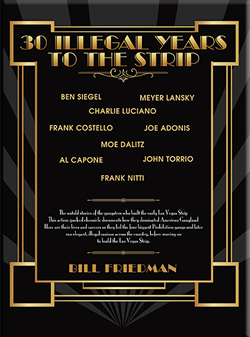Excerpt from “30 Illegal Years To The Strip”
by Bill Friedman Copyrighted 2015 ©
Chapter 16 - Go West Young Man, excerpt from pages 381-384
________________________________________________________
SIEGEL’S LOS ANGELES BUSINESS INTERESTS
Siegel was a man of leisure in LA. He had employees manage his horserace wire-service and his premier Scotch importing during World War II, and he was a silent investor in a few casinos. This allowed him to take long sea-voyage vacations. He could not have risked being incommunicado for months at a time if he were operating his own illicit businesses. While he was away he could not have protected his interests from a coup by lieutenants or a takeover by other gangs, cut the necessary deals for protection from law enforcers, arranged to protect arrested employees, or negotiated to keep them from turning state’s witness against him.

Siegel took one three-month sea expedition to search for buried treasure on the uninhabited Cocos Island 300 miles southwest of Costa Rica. He sailed a year before World War II broke out in Europe, and it turned into quite an adventure. Accompanying him were two dozen social-registry passengers and a crew of long-term inner-city buddies. He and his Hollywood socialite friend, Countess Dorothy di Frasso, financed the trip, but typical of Siegel’s legitimate business deals, he had the terms negotiated and signed by a friend, Marino Bello. He was the stepfather of actress Jean Harlow, who was Siegel’s close friend and godmother to one of his two daughters. Bello chartered the 200-foot, three-masted schooner, Metha Nelson, with the cover story it was for shark fishing in the warm waters off the Guadalupe Islands and Central America to research and market medicinal oil.
An English passenger later revealed why they went on the treasure hunt. “It is true, we were all intrigued by the gold hunt. It seems that a Canadian chap along [on the trip], Bill Bowbeer, knew a lot about a solid gold statue of the Madonna worth some fabulous sum such as $300 million. It was supposed to be encrusted with diamonds and rubies and rare stones and had been smuggled from Lima, Peru, by some priests and nuns. A Captain Thompson learned of the Madonna and reportedly murdered the religious people, stole the treasure, and then hid it on Cocos Island. Bowbeer claimed to have information about where it was hidden. We did a terrible lot of digging on the hot island and gleaned only a needed bit of exercise.” 530
The adventurers eventually tired of digging up the island only to unearth shovels left behind by earlier treasure expeditions. On their return voyage, Schooner Captain R. B. Hoffman bounced two of the crewmen in San Jose, Guatemala over an argument. The pair boarded the Italian passenger ship Cellina to return home, and Hoffman wired its Captain to have the pair arrested for mutiny. The Captain of the Cellina put the two fugitive mutineers in irons, and wired the FBI, who arrested the pair upon docking in San Pedro, California. The two Jewish crewmen denied the charges and countered they were victims of Captain Hoffman’s anti-Semitic persecution. They claimed he made their life so unbearable aboard the Metha Nelson that they had to jump ship. Two days later Captain Hoffman sent a wire from Acapulco emphatically denying he had brought mutiny charges against the pair, probably because of the unfavorable publicity he received from the crewmen in the press, but the FBI, which possessed the Captain’s original wire to the Cellina, continued its investigation.
The press reveled in the dramatically developing story about mutiny on the high seas, and the initial accusations placing racism or religious intolerance at the heart of the conflict between the German Captain and Siegel’s Jewish cohorts. This saga seemed like a prelude to World War II that Nazi Germany would launch eight months later along with its gas-chamber concentration camps. However, a much different picture of their conflict soon emerged, as every one aboard related their experiences to the FBI, a Federal Grand Jury, and the press. These explanations sounded more like an epic clash of incompatible work ethics between two divergent cultures and generations. The Captain was a German martinet, who expected strict obedience from his subordinates, while Siegel’s crew were U.S. street-punks, who considered it an obligation to defy and challenge all authority. What a volatile mix of extremes this was.
The Captain, crew, and passengers on board viewed this clash from very different vantage points. The Captain apparently realized that mutiny was too strong a term to apply to the misfit crew he had inherited, but he told the Grand Jury he found himself in command of a hell ship manned by rebellious, strong-willed men who flouted his authority at every opportunity. He complained the crew frequently brandished pistols, behaved more like gangsters than sailors, shirked their duties, and refused to obey orders. The Captain had to bail some out of Mexican jails, fight others, and use an iron fist to keep the ship running, including putting more than one man in chains. It was clear this group of armed thugs joined the cruise to have fun, and they had drinking bouts off and on the ship.

While the Captain viewed the crew as mutinous, Siegel and the crew interpreted his extremely brutal and punitive measures to maintain a semblance of discipline, such as chaining deck hands to stanchions for a week at a time, as hateful and assumed it to be racial and religious prejudice. The real problem was neither side had the slightest grasp of the other’s culture or values.
Siegel tried to mediate the conflict between the Captain and his gangster crew, but he only succeeded in aggravating it. Siegel objected to Hoffman’s brusque, dictatorial, almost demeaning attitude towards subordinates because Siegel was an outstanding leader. The employees of Siegel’s various businesses were dedicated to him because of their admiration. He set high standards, but he lavished appreciation, which inspired them to want to please him. He was the master of dangling the carrot, but he made it clear the stick was available if necessary. Siegel and the Captain were at opposite extremes of people-handling skills, and they could not bridge their differences with any type of compromise. Therefore, Siegel chose to act as a buffer every time the skipper tried to knock some discipline into the men to keep the schooner running up to his usual standards. However, this only inflamed the conflict by undermining his authority and violating a primary law of the sea - a captain has absolute command on a ship.
In contrast to the Captain and the crew, the socialite passengers said they had a great adventure, and were unaware of any conflict. Siegel had invited along wealthy friends who originated from several countries and nationalities. The English passenger summed up what the others had to say by telling reporters, “Sure, sure old man, there was a bit of bickering here and there. A bit of Scotch and soda was had by all, but really there was no mutiny. A lot of balderdash, I calls it. We really had a ripping cruise. The moonlight in the South Seas was terribly romantic.” 531
The Grand Jury no-billed the mutiny case against the two crewmen, but the FBI continued its investigation in the belief Siegel’s motive for the cruise was to harbor fugitive New York City labor racketeer Lepke Buchalter on the island and supply him money, food, and liquor. This incorrect impression resulted from Brooklyn gangster Abe Reles’ false Federal Grand Jury testimony about Siegel and Lepke being involved in the non-existent Murder, Inc. During the entire schooner trip, Lepke was hiding in an apartment near a Brooklyn police station.
The Federal Bureau of Narcotics (FBN) and U.S. Customs Service suspected Siegel was planning to use the voyage to smuggle a cargo of contraband goods, such as drugs, furs, or jewels into Los Angeles. These authorities later told the press that this was definitely proven false, but not until Customs agents obtained a search warrant in secret and did an unannounced search of Siegel’s home. They were trying to find smuggled perfume, but they apologized to Siegel as they left, “We acted on bad information.” His file was closed with a “no evidence” notation.532
On the return home, as the nightmarish conflict between the Captain and crew reached its zenith, an unrelated disaster afflicted this ill-fated voyage. The adventurers were struck by a hellacious 72-mile-an-hour gale in the Bay of Tehuantepec off Acapulco, Mexico. This fierce storm split the main mast, shredded all the sails, and broke the crankshaft of the auxiliary diesel engine that was used when the wind was insufficient to sail the ship. As the terrifying storm subsided, every one aboard felt great relief over having survived it. But this was short lived because they realized they were helplessly adrift alone in the ocean, with no means of communication. Every one aboard stood on deck scanning the horizon in every direction desperately hoping to sight another ship. A whole day passed. That night no lights were seen in the distance. Then another day passed. Finally at nightfall, they sighted the lights of the Cellina in the distance and sent up flares. The Cellina shifted from her course to reach the disabled Metha Nelson, floundering helplessly in a rough sea. The Cellina towed the schooner to Acapulco for repair.
Siegel and his friends, the Countess Dorothy di Frasso and County Jail Physician Blank, jumped ship in Ensenada because it was faster to drive back to LA than ride on the schooner’s repaired auxiliary engine without having any sails. More than three years after this expedition, Dr. Blank was fired as Jail Physician for minor favors to inmate Siegel. It is likely the temporary $32,000 loan from the Doctor was to provide Ben quick financing for this misadventure to achieve untold riches.
HOLLYWOOD’S HOODLUM SOCIALITES
